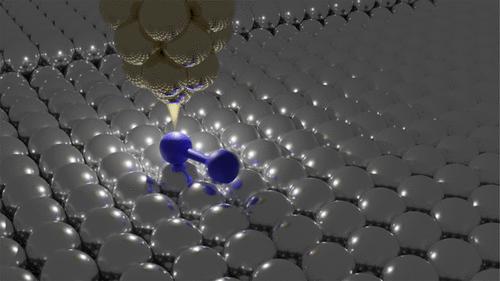Ag(100)上μ3吸附分子氧的低温STM表征
IF 3.2
3区 化学
Q2 CHEMISTRY, PHYSICAL
引用次数: 0
摘要
分子氧与金属表面相互作用的精确描述是量子化学中最具挑战性的课题之一。在这项工作中,我们使用低温扫描隧道显微镜(STM)鉴定和表征了分子氧在Ag(100)上与三个Ag原子(μ3)的吸附状态。令人惊讶的是,μ3-O2不能被广义梯度近似(GGA)级密度泛函理论(DFT)识别为稳定构型。通过非弹性电子隧道能谱(IETS),我们确定了单个μ3-O2的三种振动模式,并将它们划分为38.0 meV的面外受阻旋转(HR)、32.4 meV的面内受阻旋转(HR)和22.0 meV的面内受阻平移(HT)。我们确定了μ3-O2在隧穿电子诱导下的旋转异构化势垒为69.3 meV。理论无法预测实验很可能源于GGA-DFT固有的自相互作用误差,这导致了对局域电荷的不准确描述。我们推测μ3-O2的构型代表了一个正式的分子氧阴离子,并将其在IETS中的±11 meV激发归因于表面结合阴离子的自旋轨道态之间的跃迁。本文章由计算机程序翻译,如有差异,请以英文原文为准。

Characterization of an Unexpected μ3 Adsorption of Molecular Oxygen on Ag(100) with Low-Temperature STM
Precise description of the interaction between molecular oxygen and metal surfaces is one of the most challenging topics in quantum chemistry. In this work, we use low-temperature scanning tunneling microscopy (STM) to identify and characterize an adsorption state of molecular oxygen that coordinates to three Ag atoms (μ3) on Ag(100). Surprisingly, μ3-O2 cannot be identified as a stable configuration with generalized gradient approximation (GGA)-level density functional theory (DFT) calculations. Through inelastic electron tunneling spectroscopy (IETS), we identify three vibrational modes of individual μ3-O2 and assign them to out-of-plane hindered rotation (HR) at 38.0 meV, in-plane HR at 32.4 meV, and in-plane hindered translation (HT) at 22.0 meV. We determine the barrier for rotational isomerization of μ3-O2 to be 69.3 meV from tunneling electrons-induced rotations. The inability of theory to predict the experiment stems most likely from self-interaction errors inherent to GGA-DFT, which leads to an inaccurate description of localized charges. We speculate that the μ3-O2 configuration represents a formal molecular oxygen anion and assign the ±11 meV excitation in the IETS to a transition between spin–orbit states of the surface-bound anion.
求助全文
通过发布文献求助,成功后即可免费获取论文全文。
去求助
来源期刊

The Journal of Physical Chemistry C
化学-材料科学:综合
CiteScore
6.50
自引率
8.10%
发文量
2047
审稿时长
1.8 months
期刊介绍:
The Journal of Physical Chemistry A/B/C is devoted to reporting new and original experimental and theoretical basic research of interest to physical chemists, biophysical chemists, and chemical physicists.
 求助内容:
求助内容: 应助结果提醒方式:
应助结果提醒方式:


